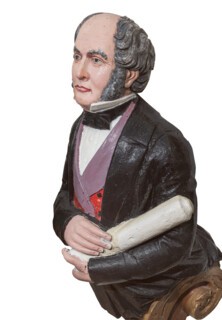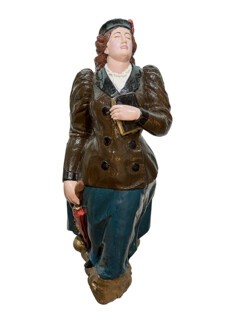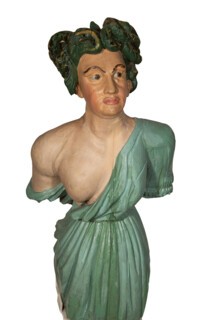In 1660, a Commonwealth warship called HMS Naseby sailed to the Dutch Republic to bring the new king-in-waiting home to England. During its journey the ship was renamed the Royal Charles in honour of the Restoration, but her figurehead – a vast carving of Cromwell on horseback, wearing laurels and ‘trampling six nations under foot’, as John Evelyn put it – remained in place. Pepys, who sat on the Navy Board, knew how expensive a replacement would be and hoped that its significance would fade with the memory of the war. In December 1663, however, ‘after it was forgot whose it was, or any words spoke of it’, riotous scenes erupted at the docks. Two of Pepys’s colleagues on the board reported that under their supervision a crowd had torn the carving from the ship, strung up ‘Oliver’s head’ from a makeshift gibbet and then cut it down to be set on fire. Pepys was horrified by the cost of the vandalism. ‘It is even the flinging away of 100l. out of the king’s purse, to the building of another, which it seems must be a Neptune,’ he wrote in disgust.
For the crowd at the quayside, the opportunity to take revenge on Cromwell’s lost head must have seemed irresistible. But the story of the head’s rise and fall also illustrates the special ability ships’ figures possessed. Like warships themselves, which were designed to represent the power of entire nations, figureheads had a synecdochic function. They ‘embodied the spirit of the ship’, as Sue Prichard and Jeremy Mitchell write in their guide to the National Maritime Museum’s collection, representing by their design some quality or attribute for which their vessels were to be known.* The Egyptians carved figures of birds symbolising keen vision through the water; the Greeks and Romans mounted wolves’ or boars’ heads for strength and ferocity. In Britain, the development of large naval galleons during the 16th century encouraged flamboyant, complex carvings, which were then replaced towards the end of the Stuart period with simpler designs: stylised lions to symbolise power and aggression, or torso carvings of mythological or historical figures. During the 18th and early 19th centuries, the production of warship heads for the navy was big business, supporting whole families of skilled carvers who based themselves at the dockyards. When, later in the century, the frequency of naval commissions began to decline with the shift from wood to iron shipbuilding, carvers continued to work on heads for merchant ships transporting goods back and forth across the empire.
Navy ships weren’t obliged to take inspiration from military or national iconography for their names and figureheads. HMS Clown (1856) was adorned with a stylised representation of the Regency comedian Joseph Grimaldi, whose catchphrase (‘Here we are again!’) was carved on a wooden banner wound around his polka-dotted legs. Merchant ship owners could name their vessels however they liked and drew on an astonishing range of references for their decorations. The merchant figureheads collection in the Cutty Sark gallery – assembled in the first half of the 20th century by Sydney Cumbers, a marine-obsessed businessman nicknamed ‘Long John Silver’ for his swashbuckling eyepatch – comprises an eclectic jumble of characters from history, literature and myth. Garibaldi, looking idealistic and clutching what might be a map, is joined by Malory’s Sir Lancelot, in full armour with pathetic blue eyes and a consumptive tinge to his cheeks. Disraeli, projecting charisma in a black dinner jacket, consorts with ‘Old Goody’, an aproned housewife, or perhaps genteel maid, with a starched white collar and pursed red lips, formerly mounted above the door of a butcher’s shop in Faversham after the wrecking of her ship. At under a metre in height, about half the size of an average ship’s head, is the delicate figure of Rose Salterne, or ‘Rose of Torridge’, the love interest of the privateer hero in Charles Kingsley’s novel Westward Ho! (1855). Rose’s grisly end – Kingsley has her burned to death by the Spanish Inquisition after she gets caught up in Drake and Raleigh’s adventures – is captured by the inclusion of a wooden stake fixed to her back, which would have projected forwards dramatically from her ship’s bow.
Choosing a female figurehead wasn’t a straightforward business. Into the 19th century sailors held onto the belief that having a woman on board – whether alive or carved – would distract them from doing their job safely and ‘anger’ the sea into a storm. One way around the problem, which we might be inclined to view somewhat cynically, was to present female torsos either naked or semi-naked. Exposed breasts, unlike clothed ones, were supposed to mollify high waves or shame them into calming themselves. The vengeful Fury Megaera, for instance, would have been considered an imprudent choice of figurehead if she hadn’t been partially undressed: she glowered from the bow of HMS Megaera (1849) with dark eyebrows and coiled serpent hair, her tunic draped to leave her right breast exposed for safety’s sake. In the case of Cutty Sark’s head, a full-length carving of the seductive witch Nannie Dee from Burns’s ‘Tam o’ Shanter’, undressing is written into the legend of the figure. In the poem, the sight of Nannie’s revealing ‘cutty sark’ (or ‘scanty’ underskirt) as she dances is what attracts Tam and almost causes his ruin; for the sailors on board ship, however, Nannie’s bare breasts would have been the only thing standing in the way of shipwreck.
Figures of real women tended to be chosen for their exemplary virtue. Pillars of respectability weren’t considered likely to distract sailors or bring bad luck at sea – which was just as well, because a topless carving of Elizabeth Fry or Florence Nightingale would certainly have been frowned on. Fry, who adorned a Victorian merchant ship, is depicted wearing a piecrust-collar shirt and bulky masculine jacket; Nightingale, from a similar vessel, has a capable-looking face with strong features, a sensible blunt-cut bob (nothing like Nannie’s wild locks) and a closed-front collared shirt up to the neck. She looks ready to stitch up a wound but hardly invites a wandering eye.
Given that the overwhelming majority of ship’s carvers and sailors were men, we might expect male figureheads to have been resolutely unsexualised. In the case of representations of historical subjects – Disraeli, Gladstone, Pitt the Younger, Nelson – there isn’t a bare torso in sight. Gladstone, figurehead on a merchant ship, is depicted as serious and cerebral, with a high stiff collar, unruly grey eyebrows and a large bald patch; Pitt, an appropriately miniature figure at half a metre tall, looks like a child dressed as a grown-up, a public schoolboy with delicate inquisitive features, round eyes and no facial hair. But depictions of historical or mythological male subjects were another matter. Carvers were free to imagine and design as they liked: who knew how Greek, Roman or Arthurian heroes really looked beyond their costumes? HMS Tribune (1853) boasted a hyper-manly Roman torso with flowing black curls, broad shoulders and taut carved abdominals running all the way up his sternum; his rampant handlebar moustache was an anachronistic flourish, designed to imbue a traditionally clean-shaven figure with hirsute Victorian chic. The head of the warship Ajax (1846), meanwhile, a towering piece at almost five metres in height, was an object lesson in camp. Ajax’s lustrous curls and plumed helmet frame fine cheekbones and sensuous lips; his low-cut tunic sits snugly against bulging pectorals and (again) curiously displaced stomach muscles. He looks virile and foppish at the same time, stoic but flirtatious.
Ajax loomed from the front of a large 74-gun vessel. Smaller and lighter warships were often named after animals rather than people, and decorated with carvings either of the beasts themselves or of beasts accompanied by human figures. Snakes might be shown wound around their charmers. Lions had been a popular choice since the late 17th century, with emphasis placed on their association with royalty. A crowned lion head from a 1720s warship in the Maritime Museum’s collection is shown resting his forepaws with their sharp triangular claws on a St George escutcheon; his mane of carved scrollwork curls and the delicate lines of fur scratched into his belly show beautiful technical range. For HMS Lion (1847), a Portsmouth carving firm submitted a design to the navy depicting an uncrowned beast and had to come back again a month later with a new design, the lion now crowned and boasting two tails.
In the 19th century, there were foxes, stags, dogs – the merchant vessel Sirius had a bright-eyed hound stretching its forelegs – and more exotic beasts from remote corners of the empire. HMS Kangaroo (1852) was decorated with a relatively convincing figure in mid-jump, as if launching itself off the ship’s bow. An unsuccessful design submission – too elaborate and expensive – for HMS Leopard (1849) featured a bust of a young hunter in a turban carrying a spear, unaware of the leopard peering out sneakily from carved grasses on the trail-board below him. On the bow of HMS Resolute (1850), an exploration ship dedicating to searching for the remains of John Franklin’s doomed Arctic expedition, there was a hopeful-looking polar bear.
In the second half of the century, the introduction of iron steamships brought an end to the production of figureheads. Unlike wooden vessels, iron ships had no need for a strengthening curved stem at the bow, which meant they didn’t need the stem-posts on which figureheads traditionally sat. Carvers left the shipyards and took up other kinds of decorative work, supplying fairgrounds with rocking horses and carousel lions. Heads from ships that hadn’t been wrecked or lost at sea ended up on land when their vessels were broken up: some were saved by collectors, but others sat in dockyards until they rotted. From the mid-19th century, those that had been recovered in decent shape from wrecks tended to be considered interesting and significant enough to preserve, and in some cases they took on a new commemorative function as the land-bound remains of lost vessels. A female Highland warrior figure in kilt and sporran was one of the few survivors of the wreck of the HMS Caledonia, driven onto the north Cornwall cliffs in high winds in 1842 (the other survivors, according to reports, were a young man from Jersey and a courageous washed-up tortoise). Soon after the disaster she was mounted on a pole driven at Morwenstow churchyard, an ornament repurposed as a grave marker. Figureheads have always looked odd on land – displaced, lumpen, surreally too big. In 1934 Eileen Agar photographed the remains of a simple female torso propped against a wall at the harbour in Charmouth in Dorset, her ear to the shingle as if trying to catch a conversation. The figure is missing an arm and her remaining hand is clenched into a fist; she looks like an ungainly stage prop, a bit of wreckage out of place and time.
Send Letters To:
The Editor
London Review of Books,
28 Little Russell Street
London, WC1A 2HN
letters@lrb.co.uk
Please include name, address, and a telephone number.





